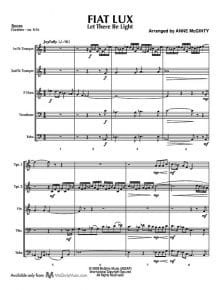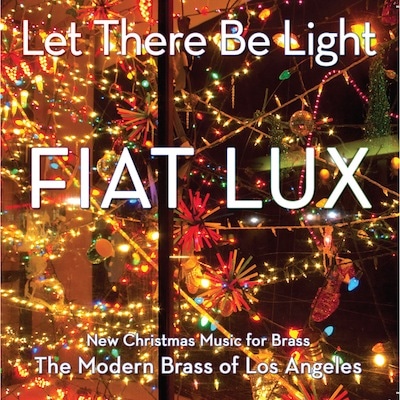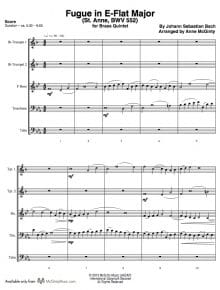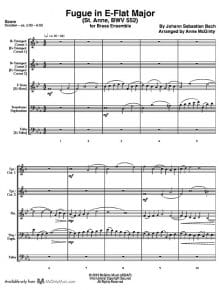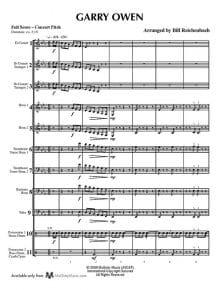Search Music
Music Categories
PDF Download Only
Purchase. Print. Play.
-
Fiat Lux (Let There Be Light) – Brass Quintet
This sparkling arrangement is a celebration of the season, featuring a montage of your favorite carols including Joy To The World, Silent Night, The First Noel, Angels We Have Heard On High, O Come All Ye Faithful, O Little Town Of Bethlehem, Ye Watchers And Ye Holy Ones and more.
This celebration of light will provide a shining moment at your Christmas concert!
Performers:
Marissa Benedict, Larry Hall – Trumpet
Andrew Pelletier – Horn
Alex Iles – Trombone
Doug Tornquist – TubaComposer: Anne McGinty
Instrumentation: 2 Bb Trumpets, F Horn, Trombone & Tuba
Duration/# of Pages: ca. 6:15 / 24 pages, 8.5″ x 11″
Key: N/A -
Fugue in E-Flat Major (J.S. Bach) – Brass Quintet
“The triple fugue … is a symbol of the Trinity. The same theme recurs in three connected fugues, but each time with another personality. The first fugue is calm and majestic, with an absolutely uniform movement throughout; in the second the theme seems to be disguised, and is only occasionally recognisable in its true shape, as if to suggest the divine assumption of an earthly form; in the third, it is transformed into rushing semiquavers as if the Pentacostal wind were coming roaring from heaven.” ~ Albert Schweitzer
The Fugue in E-Flat Major (BWV 552) has become known in English-speaking countries as the “St. Anne” because of the first theme's resemblance to the St. Anne hymn O God, Our Help in Ages Past, a hymn that would have been unknown to Bach. A fugue in three sections of 36 bars, 45 bars and 36 bars, with each section a separate fugue on a different theme, it has been called a triple fugue, although only the first theme is combined with the second and third themes; for that reason the second and third sections are sometimes referred to as double fugues. The number three is pervasive and has been understood to represent the Trinity. The description of Albert Schweitzer follows the nineteenth century tradition of associating the three sections with the three different parts of the Trinity. The number three, however, occurs many other times: in the number of flats of the key signature; in the number of sections; and in the number of bars in each section, each a multiple of 3 x 3. Each of the three themes of the fugues seems to grow from the previous ones.
Written for organ, the ranges of each of the five fugal voices works well for the five brass instruments. Articulations and minimal dynamic suggestions have been added to honor the music, to make it sound as it would have sounded if the fugue were conceived for these modern instruments. The tuba can play m. 114 to the end down an octave to sound more like an organ pedal.
This fugue is available for brass ensemble as well as brass quintet There are Eb trumpet parts included with the brass quintet version. The brass ensemble version has the traditional brass quintet parts, Eb trumpet parts, Eb horn, Euphonium TC and Eb tuba.
The mp3 excerpt is from the Tower Brass Quintet CD, Road Trip. (Used with permission.)
Composer: Anne McGinty
Instrumentation: 2 Bb and/or Eb Trumpets, F Horn, Trombone & Tuba
Duration/# of Pages: ca. 5:30 / 28 pages, 8.5″ x 11″
Key: Eb -
Fugue in E-Flat Major (J.S. Bach) – Large Brass Ensemble
“The triple fugue … is a symbol of the Trinity. The same theme recurs in three connected fugues, but each time with another personality. The first fugue is calm and majestic, with an absolutely uniform movement throughout; in the second the theme seems to be disguised, and is only occasionally recognisable in its true shape, as if to suggest the divine assumption of an earthly form; in the third, it is transformed into rushing semiquavers as if the Pentacostal wind were coming roaring from heaven.” ~ Albert Schweitzer
The Fugue in E-Flat Major (BWV 552) has become known in English-speaking countries as the “St. Anne” because of the first theme's resemblance to the St. Anne hymn O God, Our Help in Ages Past, a hymn that would have been unknown to Bach. A fugue in three sections of 36 bars, 45 bars and 36 bars, with each section a separate fugue on a different theme, it has been called a triple fugue, although only the first theme is combined with the second and third themes; for that reason the second and third sections are sometimes referred to as double fugues. The number three is pervasive and has been understood to represent the Trinity. The description of Albert Schweitzer follows the nineteenth century tradition of associating the three sections with the three different parts of the Trinity. The number three, however, occurs many other times: in the number of flats of the key signature; in the number of sections; and in the number of bars in each section, each a multiple of 3 x 3. Each of the three themes of the fugues seems to grow from the previous ones.
Written for organ, the ranges of each of the five fugal voices works well for the five brass instruments. Articulations and minimal dynamic suggestions have been added to honor the music, to make it sound as it would have sounded if the fugue were conceived for these modern instruments.
This fugue is available for brass quintet as well as brass ensemble. There are Eb trumpet parts included with the brass quintet version. The brass ensemble version has the traditional brass quintet parts, Eb trumpet parts, Eb horn, Euphonium TC and Eb tuba.
Composer: Anne McGinty
Instrumentation: 2 Bb and/or Eb Trumpets, F and/or EbHorn, Trombone and/or Euphonium & Tuba
Duration/# of Pages: ca. 5:30 / 38 pages, 8.5″ x 11″
Key: Eb -
Garry Owen – Brass Band
The arrangements in Bill Reichenbach's American Brass Band Series were written to showcase the brass band. These familiar tunes are all great audience pleasers and will be a welcome addition to your next concert.
Bill and his band, playing on restored instruments from the 1870s, performed these charts at the Great American Brass Band Festival, Custer's Little Big Horn re-enactment and brass benefit concerts to name a few.
Each arrangement has the parts numbered from the top down on both the score and the individual parts. For example, numbers 6 and 7 have parts for both trombone bass clef as well as transposing treble clef parts for tenor horns. All the optional versions of the same part have the same number, making it simple to have all the parts covered by making sure that you have someone playing all the numbers. Print all the parts or print only those you need.
This rollicking version of the Irish song Garry Owen has the following parts included:
1 – Eb Cornet
2 – Bb Cornet/Trumpet 1
3 – Bb Cornet/Trumpet 2
4 – F Horn 1
4 – Eb Horn 1
5 – F Horn 2
5 – Eb Horn 2
6 – Trombone/Tenor Horn 1 (BC)
6 – Trombone/Tenor Horn 1 (TC)
7 – Trombone/Tenor Horn 2 (BC)
7 – Trombone/Tenor Horn 2 (TC)
8 – Baritone Horn (BC)
8 – Baritone Horn (TC)
9 – Tuba (BC)
9 – Eb Tuba (TC)
9 – Bb Tuba (TC)
10 – Percussion 1 (Snare Drum)
11 – Percussion 2 (Bass Drum, Crash Cymbals)Upstate Brass Band (all Eastman School of Music students) with Kevin Michael Holzman, conductor, recorded this piece. The full version is downloadable and available at no charge.
It's also available on YouTube
Composer: Bill Reichenbach
Instrumentation: See above
Duration/# of Pages: ca. 2:15 / 53 pages, 8.5″ x 11″
Key: Eb

